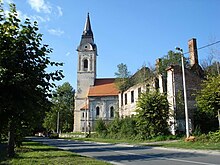| Serbian Orthodox Eparchy of Slavonia Српска православна епархија славонска | |
|---|---|
 Cathedral of Holy Trinity, Pakrac Cathedral of Holy Trinity, Pakrac | |
 Coat of arms Coat of arms | |
| Location | |
| Territory | western and central Slavonia |
| Headquarters | Pakrac, Croatia |
| Information | |
| Denomination | Eastern Orthodox |
| Sui iuris church | Serbian Orthodox Church |
| Established | 1557 |
| Cathedral | Cathedral of Holy Trinity, Pakrac |
| Language | Church Slavonic Serbian |
| Current leadership | |
| Bishop | Jovan Ćulibrk |
| Map | |
 | |
| Website | |
| eparhija-slavonska | |
Serbian Orthodox Eparchy of Slavonia (Serbian Cyrillic: Српска православна епархија славонска, Croatian: Srpska pravoslavna eparhija slavonska) is an eparchy (diocese) of the Serbian Orthodox Church encompassing areas of western and central Slavonia, Croatia. Since 2014, the Eparchy is headed by bishop Jovan Ćulibrk.
History
During the Middle Ages, the Banate of Slavonia was under the rule of Hungarian kings. By the 15th century, some eastern regions of Slavonia were inhabited by Serbs, who settled there after fleeing Bosnia, even before the Ottoman conquest in 1463. Since Serbs were Eastern Orthodox Christians, some tensions occurred with local Catholic Church. In 1438, pope Eugene IV (1431–1447) sent the inquisitor Giacomo della Marca to Slavonia as a missionary, with instruction to convert "schismatic" Serbs to "Roman religion", and if that should fail, to banish them. During that period, Serbian nobility was also present in the region. In 1454, Serbian Orthodox liturgical book, the Varaždin Apostol was written in Upper-Slavonian city of Varaždin, for princess Katarina Branković of Serbia, wife of Ulrich II, Count of Celje.
In the first half of the 16th century, entire Slavonia was devastated by frequent wars. Serbian despot Pavle Bakić fell at the Battle of Gorjani in Slavonia (1537), defending the region from the Ottoman Turks. By that time, eastern part known as Lower Slavonia was conquered by the Ottomans, while the western part (known as Upper Slavonia) came under the Habsburg rule. Since the renewal of the Serbian Patriarchate of Peć in 1557, the Orthodox Serbs of Lower Slavonia were placed under jurisdiction of the Eparchy of Požega, centered at the Orahovica Monastery. In 1595, Serbian Orthodox metropolitan Vasilije of Požega moved to Upper Slavonia, under Habsburg rule, in order to avoid the Turkish oppression.
Historically, the Eparchy was known as Eparchy of Požega (Пожешка епархија) in 16th and 17th century, and later as Eparchy of Pakrac (Пакрачка епархија). During 18th and 19th century, it was under jurisdiction of the Serbian Orthodox Metropolitanate of Karlovci that became in 1848 the Patriarchate of Karlovci. Since 1920, it belongs to the united Serbian Orthodox Church.
Heads


Metropolitans of Požega (Lower Slavonia)
- Josif (around 1585),
- Vasilije (around 1590-1595),
- Sofronije (during 16th or 17th century),
- Grigorije (during 16th or 17th century),
- Stefan (around 1641).
Bishops of Pakrac (Lower Slavonia)
- Sofronije Podgoričanin (1705–1710),
- Vasilije Rajić (1710–1714),
- Gavrilo Popović (1715–1716),
- Atanasije Radošević (1717–1720),
- Nikifor Stefanović (1721–1743),
- Sofronije Jovanović (1743–1757),
- Vićentije Jovanović Vidak (1757–1759), administration
- Arsenije Radivojević (1759–1769),
- Atanasije Živković (1770–1781),
- Josif Jovanović Šakabenta (1781–1783),
- Pavle Avakumović (178?-1786),
- Kiril Živković (1786–1807),
- Josif Putnik (1808–1828),
- Georgije Hranislav (1829–1839),
- Stefan Popović (1839–1843),
- Stefan Kragujević (1843–1864),
- Nikanor Grujić (1864–1887),
- Miron Nikolić (1890–1941),
- Damaskin Grdanički (1945–1951), administration
Bishops of Slavonia
- Emilijan Marinović (1952–1981),
- Lukijan Pantelić (1985–1999),
- Sava Jurić (1999–2013),
- Jovan Ćulibrk (since 2014)
See also
- Library of the Eparchy of Slavonia
- Serbs of Croatia
- Eastern Orthodoxy in Croatia
- List of the Eparchies of the Serbian Orthodox Church
References
- "SOC (2014): Enthronement of Bishop John (Ćulibrk) of Slavonia". Archived from the original on 2018-12-17. Retrieved 2017-04-27.
- ^ Mileusnić 1997, p. 113.
- Ćirković 2004, p. 118.
- Ćirković 2004, p. 119.
Bibliography
- Ćirković, Sima (2004). The Serbs. Malden: Blackwell Publishing.
- Krestić, Vasilije (1997). History of the Serbs in Croatia and Slavonia 1848-1914. Belgrade: BIGZ.
- Lajić, Ivan; Bara, Mario (2010). "Effects of the War in Croatia 1991-1995 on Changes in the Share of Ethnic Serbs in the Ethnic Composition of Slavonia". Stanovništvo. 48 (1): 49–73.
- Mileusnić, Slobodan (1997). Spiritual Genocide: A survey of destroyed, damaged and desecrated churches, monasteries and other church buildings during the war 1991-1995 (1997). Belgrade: Museum of the Serbian Orthodox Church.
- Miller, Nicholas J. (1997). Between Nation and State: Serbian Politics in Croatia Before the First World War. Pittsburgh: University of Pittsburgh Press.
- Вуковић, Сава (1996). Српски јерарси од деветог до двадесетог века (Serbian Hierarchs from the 9th to the 20th Century). Евро, Унирекс, Каленић.
External links
- Official website
- The Serbs in the Former SR of Croatia
- Spiritual Genocide: The Diocese of Slavonia
- Bishop Jovan: Historiography of the Holocaust in Yugoslavia
| Subdivisions of the Serbian Orthodox Church | |
|---|---|
| Metropolitanates | |
| Traditional dioceses | |
| Diaspora dioceses | |
| Historical |
|
| Cultural identity | |||||||||||||||||||||||||||||||
|---|---|---|---|---|---|---|---|---|---|---|---|---|---|---|---|---|---|---|---|---|---|---|---|---|---|---|---|---|---|---|---|
| National coordination | |||||||||||||||||||||||||||||||
| Regional coordination | |||||||||||||||||||||||||||||||
| Organizations | |||||||||||||||||||||||||||||||
| Media | |||||||||||||||||||||||||||||||
| Education |
| ||||||||||||||||||||||||||||||
| Religion | |||||||||||||||||||||||||||||||
| Political parties | |||||||||||||||||||||||||||||||
| Symbols | |||||||||||||||||||||||||||||||
| History |
| ||||||||||||||||||||||||||||||
